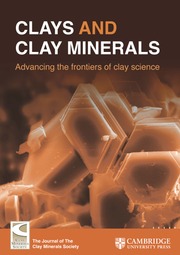Article contents
Kaolins: Sources of Differences in Cation-Exchange Capacities and Cesium Retention
Published online by Cambridge University Press: 01 July 2024
Abstract
Seven kaolins from Georgia (southeastern U.S.A.), ranging from high to low commercial grade, were characterized by X-ray powder diffraction and chemical techniques to establish that the variation in quality was caused by impurities. The Ca and Cs cation-exchange capacities (CEC) varied from 2.67 to 8.17 and from 3.29 to 8.77 meq/100g, respectively. Selective dissolution and correlation analyses strongly indicated that expandable 2:1 minerals, particularly smectite (1.2-5.9%), were responsible for most of the observed variations in Ca CEC (r = 0.85*). The external surface CEC of kaolinite ranged from 0 to 1 meq/ 100 g. The positive significant correlation (r = 0.90**) between the Ca CEC and the K-mica content (03.9%) suggested that Ca CEC may be related to the degree of mica weathering through an expandable mineral stage.
The Cs-retention capacity (0.19–1.14 meq/100 g) was closely related to Cs-measured vermiculite content (r = 0.80*), and this content plus specific surface (R = 0.93**) or mica content (R = 0.86*). The Cs retention appeared to be primarily related to the presence of interlayer wedges at mica/vermiculite XY interfaces.
Резюме
Семь каолинов из Джорджии (юго-восток США), представленные в диапазоне от высоко- до низкокачественных коммерческих марок, были охарактеризованы порошковым методом рентгеноструктурного анализа и химическими анализами, чтобы доказать что изменения качества вызываются примесями. Катионно-обменные способности (КОС) Са и Cs изменялись от 2,67 до 8,17 и от 3,29 до 8,77 М.ЭК./100 г соответственно.Селективные анализы растворения и корреляции убедительно доказали, что расширяющиеся минералы 2:1, особенно смектит (1,22–5,9%), обусловили большинство замеченных изменений КОС Са (г = 0,85*). Наружная поверхностная КОС каолинита колеблется от 0 до 1 М.ЭК./ЮО г. Существенная положительная корреляция (г = 0,90**) между КОС Са и содержанием К-слюды (02–3,9%) указывает на то, что КОС Са может быть связана со степенью выветривания слюды в течение фазы расширения минерала.
Способность удержания Cs (0,19–1,14 М.ЭК./ЮО г) тесно связана с измеренным по Cs содержанием вермикулита (г = 0,80*) и этим содержанием плюс удельной поверхностью (R = 0,93**) или содержанием слюды (R = 0,86*). Удержание Cs, по-видимому, связано в основном с присутствием межслойных клиньев в промежутках XY слюда/вермикулит. [N.R.]
Resümee
Sieben Kaoline aus Georgia (südöstliche USA), die von hoch- bis niedrig-qualitativ reichen, wurden mittels Röntgenpulverdiffraktometrie und chemischen Methoden charakterisiert, um festzustellen, daß die Qualitätsunterschiede durch Verunreinigungen hervorgerufen werden. Die Ca- und Cs-Kationenaustauschkapazitäten, (CEC), variierten von 2,67 bis 8,17 bzw. von 3,29 bis 8,77 mÄq/100 g. Selektive Auflösungs- und Korrelationsanalysen zeigen sehr stark an, daß quellfähige 2:1 Minerale, vor allem Smektit (1,2–5,9%), für die meisten der beobachteten Variationen in der Ca CEC (r = 0,85*) verantwortlich sind. Die CEC der äußeren Oberfläche von Kaolinit reicht von 0–1 mÅq/100 g. Die positive beachtliche Korrelation (r = 0,90**) zwischen der Ca CEC und dem Gehalt an K-Glimmer (0–3,9%) deutet daraufhin, daß die Ca CEC im Zusammenhang stehen könnte mit dem Ausmaß, in dem die Glimmerverwitterung durch ein Stadium eines quellfähigen Minerales geht.
Die Cs-Retentionskapazität (0,19–0,14 mÄq/100 g) stand in engem Zusammenhang mit dem Cs-gemessenen Vermiculitgehalt (r = 0,80*) und mit diesem Gehalt plus spezifischer Oberfläche (R = 0,93**) bzw. Glimmergehalt (R = 0,86*). Die Cs-Retention scheint vor allem mit der Anwesenheit von Zwischenschichtkeilen an den Glimmer/Vermikulit XY Grenzflächen im Zusammenhang zu stehen. [U.W.]
Résumé
Sept kaolins de Géorgie (Sud Est des E.U.) s’étageant de grade commercial haut à bas ont été caractérisés par diffraction poudrée aux rayons-X et par des techniques chimiques pour établir que la variation en quantité était causée par des impuretés. Les capacités d’échange de cations Ca et Cs (CEC) ont varié de 2,67 à 8,17 et de 3,29 à 8,77 meq/100 g, respectivement. Les analyses de dissolution sélective et de corrélation ont intensément indiqué que les minéraux expansibles 2:1, la smectite en particulier, (1,25,9%), étaient responsables pour la plupart des variations observées dans Ca CEC (r = 0,85*). La surface externe CEC de la kaolinite s’étageait de 0 a 1 meq/100 g. La corrélation positive significative (r = 0,90**) entre Ca CEC et le contenu en mica-K (0–3,9%) suggère que Ca CEC peut être apparenté au degré d'altération du mica à travers un stage minéral expansible. La capacité de retention-Cs (0,19–1,14 meq/100 g) était apparentée de près au contenu en vermiculite mesuré Cs (r = 0,80*), et ce contenu plus la surface spécifique (R = 0,93**) ou le contenu en mica (R = 0,86*). La rétention de Cs semblait ètre principalement apparentée à la présence de parties interfeuillets aux interfaces mica/vermiculite XY. [D.J.]
Information
- Type
- Research Article
- Information
- Copyright
- Copyright © Clay Minerals Society 1980
References
- 55
- Cited by

